 Student experiences abroad are diverse, especially within the first few weeks of arrival. Below is one student’s account of discovering a new culture in Italy.
Student experiences abroad are diverse, especially within the first few weeks of arrival. Below is one student’s account of discovering a new culture in Italy.
By Bree Barton, Amherst College:
Friday, January 6, 2006: A herd of bedraggled, jetlagged American students arrives in Italy, wide-eyed and expectant. At the airport, we’re met by the energetic members of the Umbra staff, and with suitcase(s) in hand, we commence our journey towards life, liberty, and the pursuit of property (for those whose luggage didn’t quite make the transatlantic jump). For these students, la dolce vita has just begun.
As eight chartered buses take us to Perugia, the excitement builds. The bus is eerily silent; some people are dozing, others sit with faces glued to the windows, entranced by the scenery flying by. After a few hours, the bus begins its winding ascent towards the center of town. A testament to the leisurely Italian concept of time, Christmas decorations still hang in the streets, lighting our path: prickly stars of white light piercing the cold night air. And suddenly, we’re in Perugia, the medieval hilltop city we’ll be calling home for the next four months.
How does one describe the experience of smelling, savoring, soaking up Perugia? We’ve already met quite a few Americans who say they’ve been seduced by this place, and it’s no small wonder. To succumb to the labyrinth of ancient cobbled streets, to surrender yourself to the melodic sounds of the language…this is what it means to live here. Perugia seeps into the soul.
But lest we get too carried away in mystical revelry, let’s not forget the intrusion of a few harsh realities: Why are shops closed between 1 and 4 pm daily? No laundry machines in our apartments? Heat for only eight hours a day? Our time thus far in Italy, like any time in a foreign country, demands some level of adjustment, a willingness to accept the inevitable inconveniences of a vastly different culture.
When we disembarked at the Rome airport one week ago, eyes glazed and muscles aching, we were all strangers, vaguely exhilarated and mildly terrified, completely unaware of what lay in store. Today, after a whirlwind week of orientation, moving into apartments, blossoming friendships, cultural immersion, daily language classes, cioccolato, vino, and (of course) pizza, we know this town a little better. We’ve all become better navigators, thanks to the brilliant pocket-sized map included in our Umbra orientation packets. We’re starting to be able to do Euro-Dollar conversions without the help of a calculator (though not always with pleasing results; see US government with complaints).
Students and staff have cooked and eaten together, and copious amounts of pictures have been taken. By now, most of us have ordered a cappuccino at an Italian café, even those with limited language skills. And the girls have become quite skilled at fending off amorous Italians. Our daily routine has started to sink in and feel like normal. But then we pause to take a peek out our balconies, and what do we see? A lush valley of green and brown, speckled with warm rosy homes, an occasional church steeple cresting the skyline; hillsides bathed in rural rainbows of gold and crimson and burnt orange, with massive mountains looming in the distance beyond. No; this is most assuredly not normal. Some sights remain unconquerable, defying capture by all digital conventions, equally inexplicable by prose. And we are lucky enough to be in this place.
It seems merely a trick of memory that little more than a week ago, we were living in the US, engrossed by McDonald’s, satellite TV, and central air and heat. Each day here provides a new opportunity for travel, growth and exploration, for memories to be made and chances to be taken. I wake up every morning, look out the window, breath a sigh of incredulity, and laugh at my life. Spring semester 2006, Perugia, Italy…get ready. The adventure of a lifetime awaits.
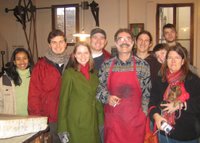 This Saturday, Umbra students were led to Città di Castello, a small Umbrian city famous in Italy as being the cradle of the country’s modern printing industry. The students had a tour of Italy’s oldest still-working printing company, run by Signor Gianni Ottaviani. Sig. Ottaviani is the seventh generation of owners of the family business, and explained that he has been setting type since he was a child. The students learned about the typographic, lithographic, and engraving processes and were given demonstrations by the enthusiastic Sig. Ottaviani in each one. The students also discussed the “ins and outs” of modern offset printing and saw how graphic layout and pagination programs are turned into printable files.
This Saturday, Umbra students were led to Città di Castello, a small Umbrian city famous in Italy as being the cradle of the country’s modern printing industry. The students had a tour of Italy’s oldest still-working printing company, run by Signor Gianni Ottaviani. Sig. Ottaviani is the seventh generation of owners of the family business, and explained that he has been setting type since he was a child. The students learned about the typographic, lithographic, and engraving processes and were given demonstrations by the enthusiastic Sig. Ottaviani in each one. The students also discussed the “ins and outs” of modern offset printing and saw how graphic layout and pagination programs are turned into printable files.



 In the first of Umbra Institute’s “Lost Weekend” trips, fourteen students boarded a chartered bus with few details about their destination. The first stop for the group was a surprise dinner at “La Cantina,” a classic Umbrian restaurant in the center of medieval Castiglione del Lago, which sits on a hill high over Lago di Trasimeno. After an “antipasto misto” of cheese and Umbrian salami, the students had “picci all’aglione,” a hearty, garlic-laced pasta dish with handmade pasta.
In the first of Umbra Institute’s “Lost Weekend” trips, fourteen students boarded a chartered bus with few details about their destination. The first stop for the group was a surprise dinner at “La Cantina,” a classic Umbrian restaurant in the center of medieval Castiglione del Lago, which sits on a hill high over Lago di Trasimeno. After an “antipasto misto” of cheese and Umbrian salami, the students had “picci all’aglione,” a hearty, garlic-laced pasta dish with handmade pasta.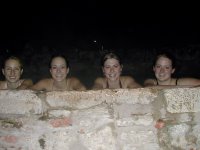



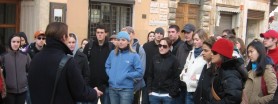
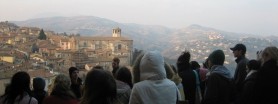

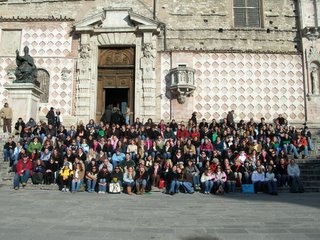 Nearly 200 students arrived in Perugia last week to begin the Spring 2006 semester. These students, like the ones who have studied at Umbra before them, have already begun the language immersion program at the Universita per Stranieri and at the Institute. This intensive program is one of the unique benefits of studying in Perugia.
Nearly 200 students arrived in Perugia last week to begin the Spring 2006 semester. These students, like the ones who have studied at Umbra before them, have already begun the language immersion program at the Universita per Stranieri and at the Institute. This intensive program is one of the unique benefits of studying in Perugia.

